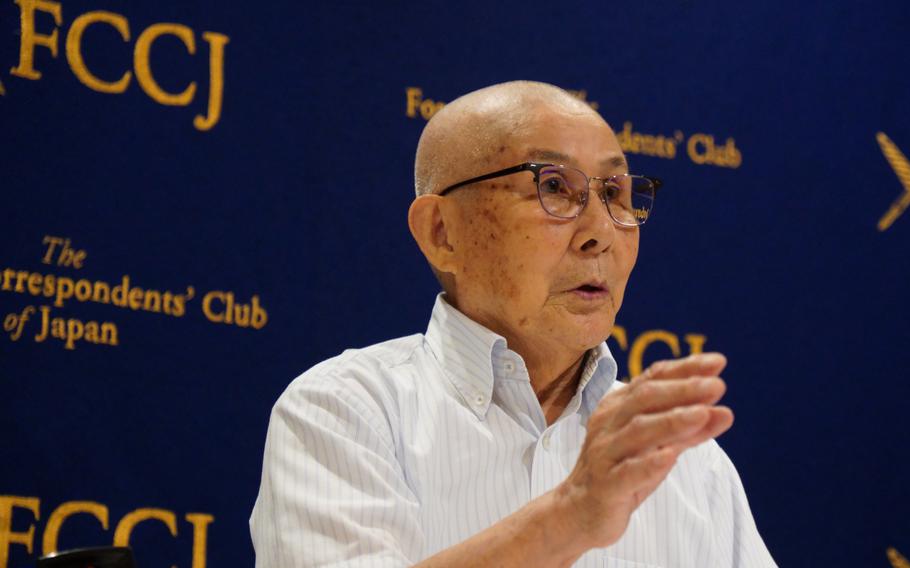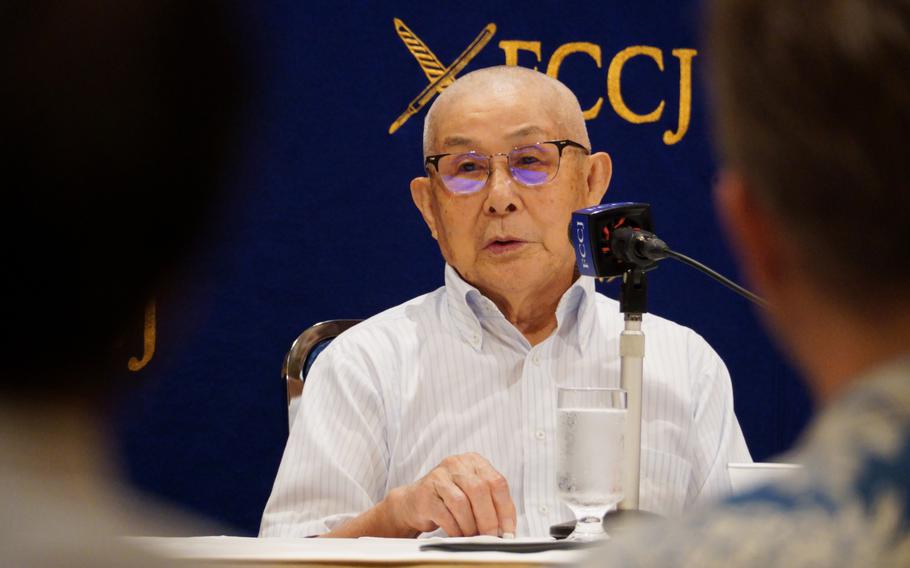
Tatsukuma Ueno, who trained kamikaze pilots during World War II, speaks with reporters at the Foreign Correspondents' Club of Japan in Tokyo, July 8, 2025. (Akifumi Ishikawa/Stars and Stripes)
TOKYO — A former Japanese army pilot who helped train the infamous kamikaze — flyers who deliberately crashed into their targets — is still telling his story 80 years after the end of World War II, in part to honor friends who died during the conflict.
Tatsukuma Ueno, 97, took the stage Tuesday at the Foreign Correspondents’ Club of Japan in Tokyo — his stride belying his age and stature — to speak quietly but confidently about his experience as a pilot in the war’s final year.
Ueno said he joined the Imperial Army at age 15 through a “junior pilot” program in 1944, approximately three years after Japan attacked Pearl Harbor and a year before its surrender in 1945.
Speaking with reporters Tuesday, he described how his childhood in Japanese-occupied Manchuria led him to dream of being in the military.
“The only playground we had was the military area, so I played with the soldiers — they were my playmates, so to speak,” he said through a translator. “So ever since I was in elementary and junior high school, I was living on the battlefield, and I had this admiration towards the soldiers.”
Japan’s military was on its back foot in 1944 following significant defeats from Midway to Saipan, that depleted its pilots and aircraft.
Ueno was hurried through pilot training and in 1945 assigned to the 66th Air Squadron on a Mitsubishi Ki-51a, the Type 99 assault plane. From there, he assisted in training and transporting kamikaze pilots.
The kamikaze — Japanese for “divine wind” — were typically young pilots who flew suicide missions. They would deliberately crash their aircraft – often loaded with extra explosives or fuel – into their targets.
“In just three months or so, more than 70 of my colleagues died, and therefore I want to pay tribute to them,” said Ueno, adding that he attends a memorial service for them every year.
During the war, Ueno didn’t consider suicide in service of Japan as extreme, he said.
“Ever since we were small, we were told that we should serve our country. This was the education we received from a very early age, and also our parents were telling us the same thing,” he said.
“It was something obvious. It was a mission for us, that we serve our country and die for our country,” he said.

Tatsukuma Ueno, who trained kamikaze pilots during World War II, speaks with reporters at the Foreign Correspondents' Club of Japan in Tokyo, July 8, 2025. (Akifumi Ishikawa/Stars and Stripes)
Ueno was never called to fly a kamikaze mission. His squadron was ultimately relocated to Kagoshima prefecture to participate in the Battle of Okinawa, but that conflict concluded before he could sortie. The war ended shortly afterwards, and his squadron was disbanded.
After the war, Ueno became a carpenter, his way of helping to rebuild his country, he said. As he grew older, he became a storyteller and shares his war experiences before they pass from living memory.
As of March 2024, fewer than 1,100 veterans of the Imperial Japanese Army are still alive, the Asahi Shimbun reported in August.
Ueno expressed his gratitude for how Japan has changed since World War II.
“This is totally different from the environment in which I was brought up,” he said. “I think the fact there is no war and that peace prevails is the best thing you can have.”